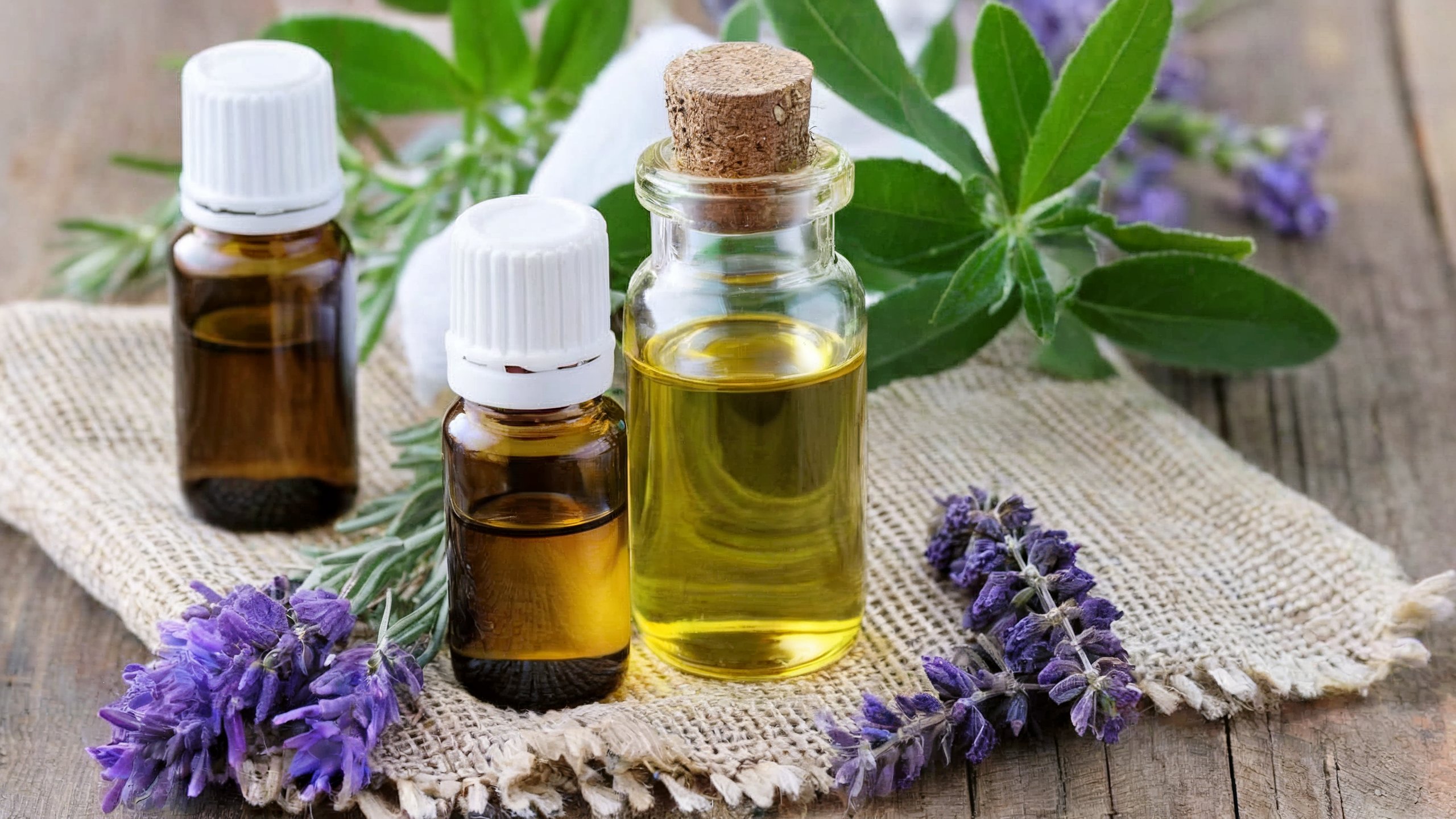Essential oils offer a natural approach to anti-aging skincare, combining centuries-old wisdom with modern scientific understanding. These concentrated plant extracts contain powerful compounds that can help reduce fine lines, boost collagen production, and improve skin texture. From lavender to frankincense, each oil brings its own set of beneficial properties to help women maintain youthful, radiant skin.
Recent research has revealed the scientific mechanisms behind essential oils’ effectiveness in skincare. These natural substances penetrate the skin’s deeper layers, where they stimulate cellular renewal and protect against free radical damage. The molecular structure of essential oils allows them to work in harmony with the skin’s natural processes, supporting its ability to repair and regenerate.
The following sections will guide you through selecting the right oils for your anti-aging goals, proper dilution methods, and effective application techniques. You’ll learn how to create personalized oil blends and incorporate them into your daily skincare routine. Ready to discover how these powerful botanicals can transform your skincare routine? Let’s explore the wonderful world of anti-aging essential oils.
Which Essential Oils Work Best for Anti-Aging?
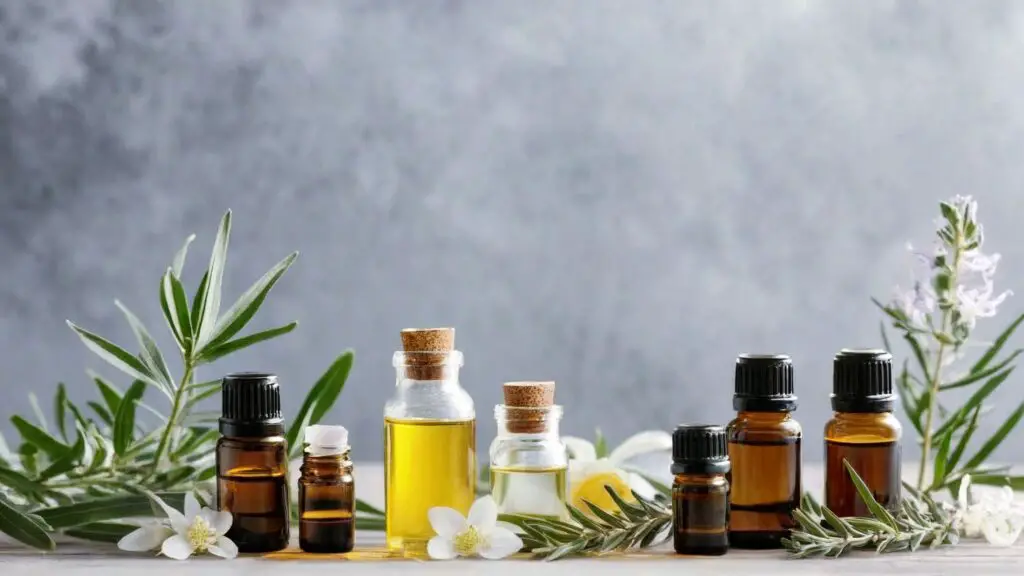
Selecting the right essential oils for anti-aging requires understanding their specific benefits and properties. Nature has provided numerous oils with remarkable skin-rejuvenating abilities, each working differently to combat signs of aging. Your perfect anti-aging solution might be hiding in these powerful plant extracts.
Most Effective Oils for Wrinkle Reduction
Frankincense oil stands at the forefront of natural wrinkle-fighting ingredients. Its molecular structure allows deep penetration into skin layers, where it stimulates cell regeneration and reduces the appearance of fine lines. Combined with rosemary oil, these natural ingredients create a potent blend for smoother skin.
Here are the top wrinkle-fighting essential oils:
- Frankincense: Promotes cell regeneration
- Rosemary: Tightens sagging skin
- Myrrh: Strengthens skin tissue
- Helichrysum: Reduces deep wrinkles
- Carrot seed: Rejuvenates tired skin
Oils that Boost Collagen Production
Your skin’s collagen production naturally decreases with age, but certain essential oils can help stimulate its production. Geranium oil particularly excels at encouraging new collagen formation, while rose oil supports the skin’s natural regeneration process.
Sandalwood oil deserves special attention for its ability to activate genes responsible for collagen synthesis. This makes it an invaluable addition to any anti-aging routine, especially when paired with other collagen-boosting oils.
Oils with Powerful Antioxidant Properties
Free radical damage accelerates skin aging, but antioxidant-rich oils provide excellent protection. Pomegranate seed oil contains high levels of punicic acid, a powerful antioxidant that fights oxidative stress. Similarly, rosehip oil delivers a concentrated dose of vitamin C and E directly to your skin.
Best Oils for Skin Firmness
Loss of firmness can age your appearance significantly, but specific essential oils work wonders in improving skin tone. Cypress oil excels at tightening loose skin, while patchouli oil helps maintain skin’s structural integrity. These oils work through different mechanisms to support your skin’s natural firmness.
The magic happens when you combine multiple firming oils together. For example, mixing cypress with patchouli creates a synergistic effect that enhances their individual benefits. Adding a few drops of lemon oil can further amplify the firming results.
Oils that Improve Skin Elasticity
Maintaining skin elasticity becomes crucial as we age. Neroli oil shines in this category, promoting elastin production while maintaining skin moisture. Lavender oil complements these effects by supporting skin cell renewal and improving overall skin texture.
Creating an effective blend requires understanding how different oils work together. Try mixing three drops each of neroli and lavender with two drops of ylang-ylang for a powerful elasticity-boosting combination. This mixture helps maintain skin bounce and resilience while providing a pleasant aromatic experience.
Your skin deserves gentle yet effective care, and these essential oils offer exactly that. Start with one or two oils that address your primary concerns, then gradually expand your collection as you become more familiar with their effects on your skin.
What’s the Right Way to Dilute Essential Oils?
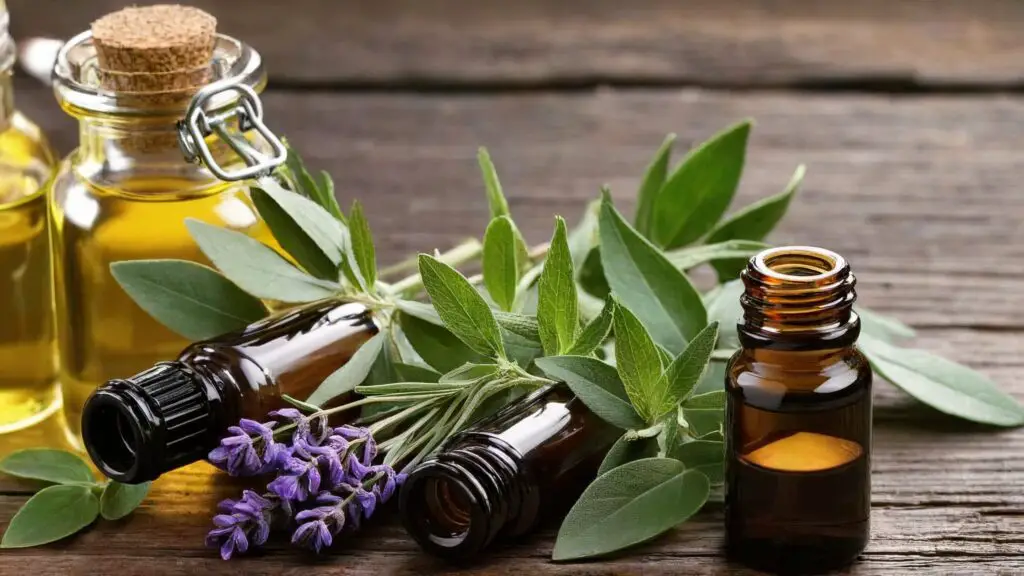
Using essential oils directly on your skin can cause irritation and sensitivity. The proper dilution process creates a safe and effective skincare solution that maximizes the benefits while protecting your skin. Let’s explore the correct methods for diluting these powerful plant extracts.
Selecting the Perfect Carrier Oil
Your choice of carrier oil can significantly impact the effectiveness of your skincare blend. Different carrier oils offer varying absorption rates and additional skin benefits. Jojoba oil mimics your skin’s natural sebum, making it an excellent base for facial applications. Sweet almond oil provides vitamin E and helps maintain skin moisture levels.
The molecular weight of your carrier oil matters too. Lighter oils like grapeseed penetrate quickly, while heavier ones like avocado create a protective barrier. Consider your skin type and concerns when selecting your base oil.
Proper Dilution Ratios for Facial Use
Creating the right concentration for facial application requires precision and careful measurement. The general rule for facial applications follows these guidelines:
- Normal skin: 1% dilution (6 drops per ounce of carrier oil)
- Sensitive skin: 0.5% dilution (3 drops per ounce of carrier oil)
- Spot treatments: 2% dilution (12 drops per ounce of carrier oil)
- Weekly treatments: 1.5% dilution (9 drops per ounce of carrier oil)
- Under-eye area: 0.5% dilution (3 drops per ounce of carrier oil)
Best Carrier Oils for Mature Skin
Mature skin requires carrier oils with specific nourishing properties. Rosehip oil stands out for its vitamin A content and cell-regenerating abilities. Argan oil provides essential fatty acids that support skin elasticity and reduce fine lines.
Pomegranate seed oil deserves special attention for its anti-aging properties. Rich in punicic acid and antioxidants, it helps fight free radical damage while supporting skin cell renewal. Mixing different carrier oils can create a more comprehensive treatment approach.
Essential Safety Guidelines
Safety should always be your top priority when working with concentrated plant extracts. Start with a patch test on your inner arm before applying any new blend to your face. Wait 24 hours to check for any adverse reactions.
Never skip the dilution process, even if you’ve used these products before. Pure essential oils can cause chemical burns, sensitization, and long-term skin damage. Keep your blends away from your eyes and mucous membranes.
Mixing and Storage Tips
The way you mix and store your diluted oils affects their potency and shelf life. Use dark glass bottles to protect your blends from light degradation. Store them in a cool, dark place to maintain their therapeutic properties.
Small batches work better than large ones. Mix only what you’ll use within a month to prevent oxidation and maintain freshness. Clean your mixing tools thoroughly between uses to prevent contamination.
Temperature changes can affect oil stability. Keep your blends at room temperature, away from direct sunlight and heat sources. Label each bottle with the creation date and ingredients used.
Your diluted essential oil blend should feel gentle and comfortable on your skin. If you experience any tingling or irritation, wash the area immediately with mild soap and water. Adjust your dilution ratio as needed based on your skin’s response.
How Do You Layer Essential Oils in Your Skincare Routine?
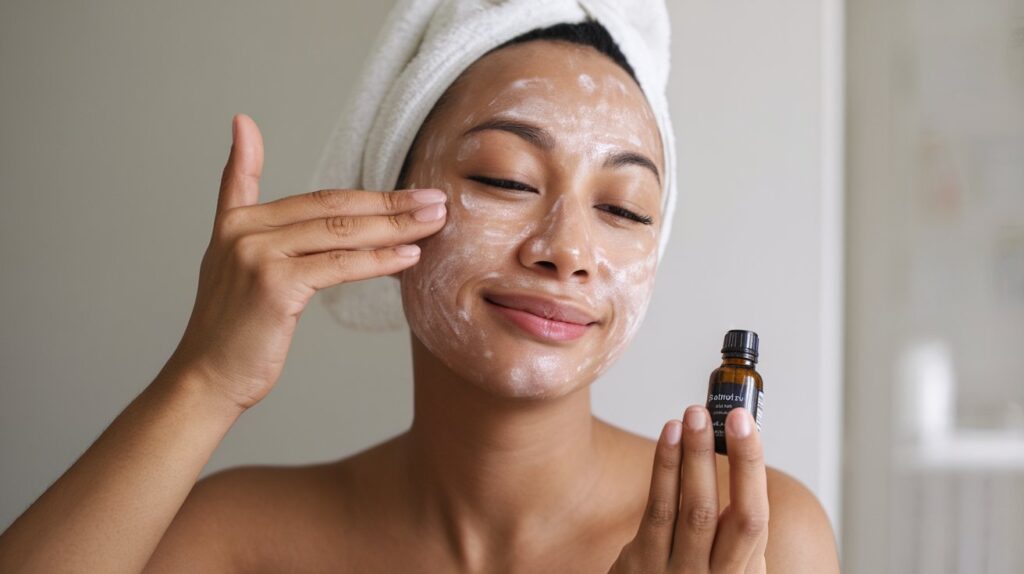
The sequence of applying skincare products significantly affects their absorption and effectiveness. Proper layering helps each ingredient penetrate the skin optimally, maximizing their anti-aging benefits. Your morning and evening routines require different approaches to support your skin’s natural rhythm.
Morning Routine Application Order
Start your day with a gentle cleanser before applying any oils. The morning routine focuses on protection and prevention, so your oil application should complement these goals. Here’s your step-by-step morning sequence:
- Cleanse with a mild facial wash
- Apply hydrating toner (if used)
- Layer essential oil blend
- Wait 2-3 minutes
- Follow with moisturizer
- Finish with sunscreen
Evening Routine Steps
Nighttime presents the perfect opportunity for skin repair and regeneration. Your skin’s natural healing processes peak during sleep, making this the ideal time for intensive oil treatments. Apply your evening oil blend after double cleansing to remove makeup and daily impurities.
Two or three drops of your chosen blend provide sufficient coverage for your entire face. Gently press the mixture into your skin rather than rubbing it. This method prevents pulling on delicate facial tissues while promoting better absorption.
Optimal Timing Between Products
Patience plays a crucial role in product layering. Allow each layer to absorb fully before applying the next. The general rule suggests waiting 60-90 seconds between applications, though this may vary depending on your skin type and product consistency.
Oil-based products need extra time to penetrate. Give your skin 3-5 minutes after applying your essential oil blend before moving on to the next step. This waiting period allows the active ingredients to properly settle into your skin.
Combining with Other Skincare Products
Some ingredients work synergistically with essential oils, while others might reduce their effectiveness. Vitamin C and retinol require special consideration. Use these active ingredients in separate routines from your oil applications to prevent any potential interactions.
Hyaluronic acid pairs exceptionally well with essential oil blends. Apply your hyaluronic acid serum first, then follow with your oil mixture. This combination creates an effective moisture-locking system for your skin.
Application Techniques for Best Absorption
The way you apply your oils can enhance their benefits. Using proper techniques helps the active compounds reach deeper skin layers where they can work most effectively. Start from the center of your face and work outward using gentle, upward strokes.
Facial massage increases product absorption while stimulating blood flow. Use your ring fingers to apply gentle pressure in circular motions, focusing on areas prone to aging. Pay special attention to the forehead, around the eyes, and along the jawline.
Temperature affects absorption rates. Slightly warm hands before applying oils by rubbing them together briefly. This simple step helps the products melt into your skin more readily and increases their penetration.
Your skin type determines the pressure needed during application. Dry skin benefits from firmer pressure to stimulate oil production, while sensitive skin requires a lighter touch. Adjust your technique based on how your skin responds.
Creating Your Anti-Aging Oil Blends
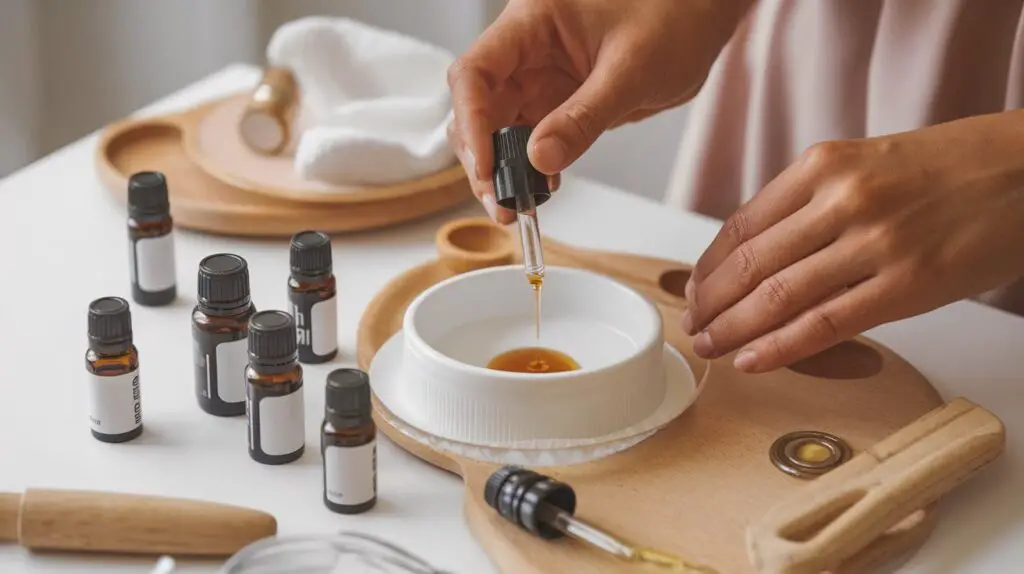
Making your own anti-aging oil blends allows you to customize formulations for your specific skin needs. The art of blending requires understanding how different oils interact and complement each other to create effective skincare solutions.
Basic Blending Principles
Start with three to five oils maximum in your blend. This approach helps you identify which ingredients work best for your skin. The foundation of any successful blend consists of one base oil, one to two supporting oils, and one accent oil for targeted benefits.
Think of blending like cooking – you need a recipe to follow before experimenting. These basic formulas will get you started with your first blend:
- Wrinkle-fighting blend: 4 drops frankincense + 3 drops lavender + 2 drops rose
- Firming blend: 5 drops geranium + 3 drops cypress + 2 drops lemon
- Brightening blend: 4 drops carrot seed + 3 drops neroli + 2 drops sandalwood
Measurements and Proportions
Precision matters in creating effective blends. A standard 1-ounce (30ml) bottle of carrier oil requires specific amounts of essential oils based on your skin’s sensitivity. For facial applications, stick to a 1% dilution ratio initially.
The math behind proper dilution is straightforward: one percent equals six drops of essential oil per ounce of carrier oil. Double-check your measurements using a glass dropper for accuracy. Count drops slowly and carefully to maintain proper ratios.
Synergistic Oil Combinations
Some oils work better together than alone. Frankincense and myrrh create a powerful anti-aging duo, while rose and geranium complement each other’s skin-rejuvenating properties. Understanding these relationships helps create more effective formulations.
Lavender acts as a bridge between different oils, making it an excellent addition to most blends. It helps balance stronger scents while adding its own anti-aging benefits. Consider adding two drops to any combination that seems incomplete.
Storage Requirements
Dark glass bottles protect your blends from light degradation. Amber or cobalt blue bottles work best, as they filter out harmful UV rays that can diminish the potency of your mixtures. Store all bottles in a cool, dark cabinet away from direct sunlight.
Keep your blending tools clean and dry. Contamination can reduce the effectiveness of your formulations and potentially cause skin reactions. Use separate droppers for different oils to prevent cross-contamination.
Temperature fluctuations affect oil stability. Find a storage spot that maintains a consistent temperature between 35-40°F (15-20°C). The bathroom might seem convenient but isn’t ideal due to humidity and temperature changes.
Shelf Life Considerations
Different oils have varying shelf lives. Carrier oils typically last 6-12 months, while essential oils can maintain their properties for 1-2 years when stored properly. Write the creation date on each bottle to track freshness.
Your nose knows best – if a blend smells rancid or different from its original scent, it’s time to make a fresh batch. Small batches prevent waste and maintain maximum effectiveness. Mix only what you’ll use within a month.
Watch for changes in color or consistency, as these can indicate oxidation. A blend that separates or becomes cloudy might have expired. Always perform a patch test before applying a stored blend to your face, even if it’s within its expected shelf life.
What Are the Best Application Methods?
The method you use to apply essential oils can significantly boost their effectiveness. Your fingertips can become powerful tools for enhancing absorption and maximizing the benefits of these natural compounds. Let’s explore the most effective application techniques for your anti-aging routine.
Facial Massage Techniques
Your facial muscles need stimulation to maintain their tone and firmness. Starting from the center of your face, use gentle upward and outward motions to distribute the oils. These basic massage movements support lymphatic drainage and boost circulation:
- Forehead: Sweep outward from center to temples
- Cheeks: Circle upward from nose to ears
- Jawline: Glide forward from ears to chin
- Neck: Stroke downward toward collarbones
- Under eyes: Tap gently with ring finger
Pressure Point Application
Specific points on your face respond well to gentle pressure during oil application. The temples, third eye area, and jaw joints benefit from small circular motions. Hold each point for 3-5 seconds while breathing deeply.
Traditional Chinese medicine identifies several facial pressure points that can enhance skin health. Massaging these areas helps reduce tension that contributes to fine lines and wrinkles. Pay special attention to the points beside your nose and under your cheekbones.
Tools for Oil Application
While fingers work well, certain tools can enhance your application process. A jade roller or gua sha tool can provide deeper penetration and more consistent pressure. These implements also stay cool naturally, which helps reduce puffiness.
Rose quartz facial rollers offer both physical and energetic benefits. The cool stone helps contract blood vessels, while the rolling motion encourages lymphatic drainage. Clean your tools after each use with mild soap and water.
A facial massage brush with soft bristles provides gentle exfoliation while applying oils. This combination of effects stimulates cell turnover and improves product absorption. Choose brushes specifically designed for facial use to avoid irritation.
Frequency of Use
Morning and evening applications provide optimal results. Your skin repairs itself during sleep, making nighttime application particularly beneficial. However, some oils increase sun sensitivity, so check product guidelines for daytime use.
Your skin type determines ideal application frequency. Dry skin might benefit from twice-daily applications, while oily skin might need only evening treatments. Start with once-daily use and adjust based on your skin’s response.
Signs of Effectiveness
Positive results often appear gradually over several weeks of consistent use. Initial signs include improved skin texture and a natural glow. Your skin should feel soft and supple, not greasy or irritated.
Watch for these indicators of successful application:
- More even skin tone
- Reduced appearance of fine lines
- Improved skin elasticity
- Better moisture retention
- Smoother texture
Track your progress with weekly photos in natural light. Changes might be subtle at first, but comparing images over time reveals improvements. Keep notes about which techniques work best for your skin type and concerns.
The temperature of your hands affects oil absorption. Warm your palms by rubbing them together before applying products. This simple step helps the oils penetrate more effectively into your skin layers.
Your Path to Radiant, Youthful Skin
Essential oils offer a natural approach to maintaining youthful, glowing skin when used correctly and consistently. The combination of proper dilution, strategic layering, and effective application techniques creates a powerful anti-aging routine that works in harmony with your skin’s natural processes. From selecting the right carrier oils to mastering facial massage movements, each step builds upon the next to maximize the benefits of these botanical extracts.
Your skincare journey becomes more rewarding as you discover which combinations and techniques work best for your specific needs. Taking time to blend, apply, and massage these natural ingredients into your skin isn’t just about anti-aging – it’s a daily ritual of self-care that promotes both outer beauty and inner well-being. As you incorporate these methods into your daily routine, you’ll develop a deeper understanding of your skin’s needs and responses, leading to more effective and personalized skincare solutions.
Frequently Asked Questions
Q: What’s the ideal dilution ratio for essential oils on facial skin?
A: For facial application, use a 1% dilution ratio, which equals 6 drops of essential oil per ounce of carrier oil. For sensitive skin, reduce to 0.5% (3 drops per ounce).
Q: How long should I wait between applying different skincare products?
A: Wait 60-90 seconds between regular products, and 3-5 minutes after applying essential oil blends to allow proper absorption.
Q: Can I mix essential oils with active ingredients like retinol?
A: No, use essential oils and active ingredients like retinol or vitamin C in separate routines to prevent interactions that could reduce their effectiveness.
Q: What’s the best way to store essential oil blends?
A: Store blends in dark glass bottles (amber or cobalt blue) in a cool, dark place at 35-40°F (15-20°C), away from sunlight and humidity.
Q: How long do essential oil blends last?
A: Mixed blends typically last one month. Individual essential oils last 1-2 years, while carrier oils last 6-12 months when stored properly.
Q: What’s the correct massage technique for applying facial oils?
A: Use gentle upward and outward motions, starting from the center of your face. Apply light pressure and move toward the lymph nodes to promote drainage.
Q: How often should I apply essential oil blends to my face?
A: Apply once daily initially, preferably in the evening. Adjust to twice daily based on your skin’s response, but check if oils cause sun sensitivity before daytime use.
Q: How can I tell if my essential oil blend is working?
A: Look for improved skin texture, more even tone, reduced fine lines, better moisture retention, and increased elasticity after several weeks of consistent use.

